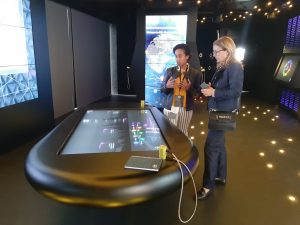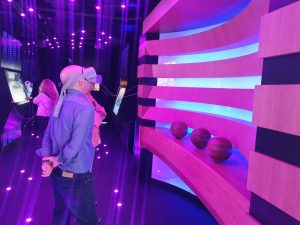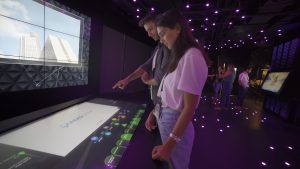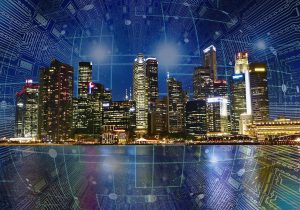Welcome to Tel Aviv. In one of the main streets of the city selected in 2014 for the smartest city in the world, the Smart Cities Innovation Center (MIC) was recently launched, which was designed and produced by Orpan Group for Local Government Center in Israel. Here, in one place presented to the visitor a variety of technological results that offer a comprehensive solution to the scope of challenges and needs that spring up because of the rapid population growth and concentration in large, crowded metropolises.
The uplifting tone of the visit is that the future is already here.

When the vision meets reality: a challenge and its name is soot
7 floors down, at the foundation of the state-of-the-art luxury tower where MIC is located, we fill a slightly different Reality. The bus roar is accompanied by traffic jams and troubled drivers searching for vacant parking places, sidewalks laden with businessmen exiting the towers and making their way to lunch, along with schoolchildren waiting long for the latest shuttle to arrive – noise and crowding still characterize the busy urban areas.

This scenario is part of the daily reality for many of the metropolitan residents and visitors around the universe. Population density, air pollution, traffic jams and inefficient utilization of municipal space – all significantly impair the quality of life in the city. Since more than half of the world’s population currently resides in cities, a growing rate year by year and is expected to reach as much as 70% by 2050, the future requires us to think, design and set up an appropriate urban model.
The Smart City Vision tries to address many of the challenges that big busy cities face. The smart city model not only permits to minimize many of the problems but also to address important matters that have not previously received public attention, with the object of establishing the urban area greener, healthier, more social and much more convenient for residents and visitors to the city.
The wisdom of cities: Knowledge is power

Smart cities are cities that can disseminate and analyze metrics for information entry and analysis. The analysis lets you know how to utilize urban resources in the most efficient and convenient way possible: Analyzing the movement of vehicles and people in real-time, for example, may save time for all of us waiting for traffic lights and traffic jams. Placing air pollution indicators can help us identify the force that emits harmful substances to our bodies (Especially after the days of the Coronavirus). Systems that enable large-scale data analysis quickly and efficiently will allow us to better plan the city, the convenience, and well-being of its residents, employees, and visitors. Good and efficient communication with residents and visitors, through dedicated Apps and sites, will enable the flow of knowledge between the authorities and residents and visitors, and make available information in real-time. However, Raw knowledge is unlikely to be enough to bring us unique solutions to the complex problems we confront. To do this, we need to encourage innovation, creativity and thinking outside the box.

Municipal Innovation Center: The smart city is already here
As befits its name, the Municipal Innovation Center has an up-to-date, cutting-edge look that emphasizes that the technology front is already here, and solutions are available for application in the field. The purpose of the designed spaces is to provide a platform for accessing existing knowledge about the smart city model.

To establish the right impression, visiting the center creates a multi-sensory, interactive experience. In the middle of the space stands an impressive white urban model, on which data is mapped by video mapping technology. Around it are stands dealing with diverse urban issues, including education, green construction and cyber, exemplified by the use of VR glasses, interactive smartphones and other experiential visuals, which show visitors how the smart city vision can be realized here and now. In another corner, live examples are presented. The use of lighting poles as solar charging stands, and sensors located in “smart bins” connected to the garbage disposal app for better management. Testing these tangible pieces combined with augmented reality technology (AR) will let the visitor acquire more information and more possible applications for practical and efficacious usage in his private municipal sector. The following stop will determine an index screen that lists all the High-tech companies and current innovations in smart city affairs by topic and incorporates video accessible. All this – In a way that presents the visitors (most of whom belong to local government entities) inspiration and actual toolbox to use.

Dr. Yaron Meiri. Owner & CEO at Orpan Group LTD.
However, according to Dr. Yaron Meiri, owner and CEO of Orpan Group, MIC has an even more significant role: “Beyond the vast knowledge that is here for all the innovators and the innovative technologies we have embedded at the center, I think MIC’s highlight is the platform for holding a discussion and brainstorming between Local government officials who represent the need arising from the area and the companies that work on solutions accordingly”.
In a separate area inside the complex is the “HUB”. A place, with a system that allows its visitors to examine the smart projects currently in the implementation stages before the actual field experiment. The HUB is, in fact, an exclusive area for local government officials to learn in detail the best course of action that will allow their city to implement fresh technologies.
Dr. Meiri adds: “This place allows visitors to express their opinions on the same topics, raise points for discussion and write their professional opinions on the projects presented on the site – comments that will help those who follow them. If we said knowledge is power, then its sharing is a force multiplier. ”

The illustration creates a reality
The advantage that a center like MIC has, as stated, is the vision. The small details are the ones that make the big difference, and in this case – they are the ones who can present the visitor with the real picture of the possible future. Following a standard smart city presentation will not compare to its essence of meeting directly with existing projects and contacting existing developments. A glance into the outline of future cities, including complex illustration models, which exhibit different ways of transport design and a deep layer of “breathable” green, can certainly expose decision-makers to a coherent picture of a smart city, and even gradually adopt appropriate new technologies.
To conclude, I chose to quote Dr. Meiri at the RE 360 conference held in Istanbul at the end of 2019: “Experiential exposure to the new concept of the smart city, leading to the recognition and internalization of its many advantages over the existing situation – may lead us straight into the future. And this feature is only getting better!”





